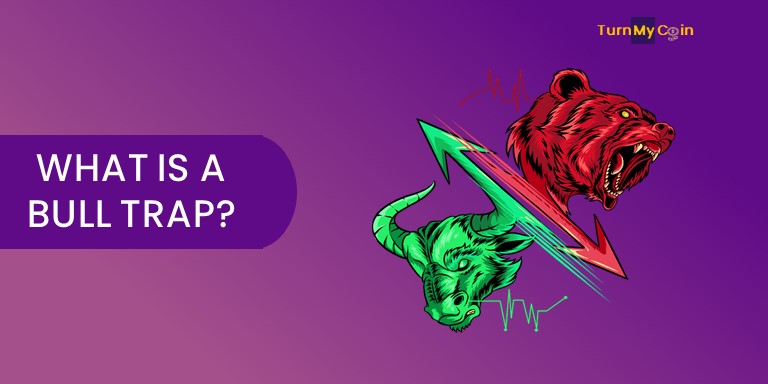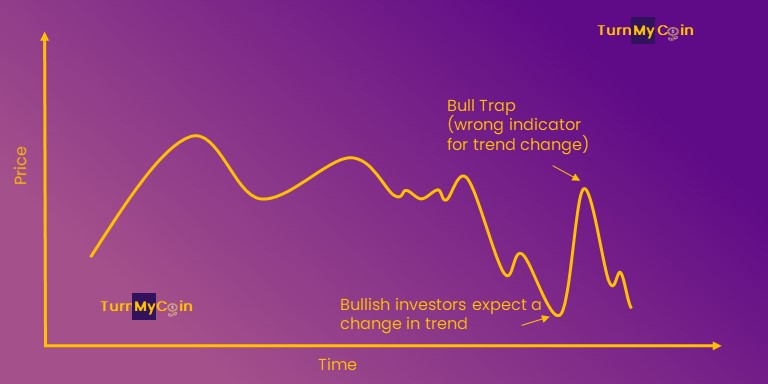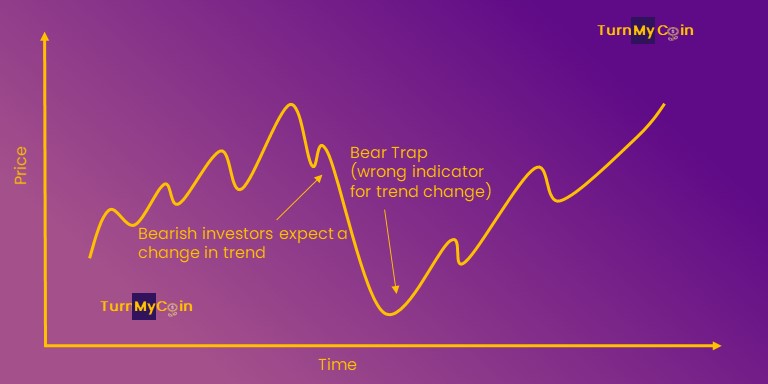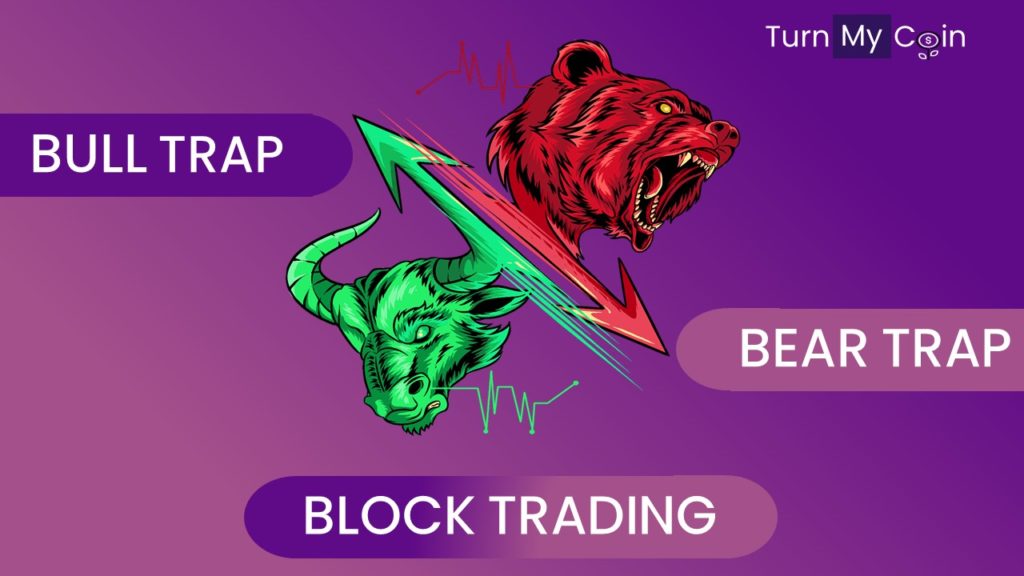Last updated on February 20th, 2024 at 11:15 am
Introduction
The cryptocurrency market is full of intricacies. It has loads of complexities which if properly analysed can provide high returns and on the flip side, high losses. We are going to discuss some of the tricky topics in this article namely Bull Trap, Bear Trap and Block Trading.
Please note this article is for informational purposes only, cryptocurrency is a volatile field, please do your own research before investing.
Cryptocurrency trading is one of the many ways to earn money apart from Staking, Mining, Yield Farming etc. An investor needs to know about certain concepts before diving into trading. Traps exist in capital markets such as crypto, stocks, and forex, all of which prey on unsuspecting and emotional retail traders. Bear traps and bull traps are two of the most prevalent.
To become a better and more profitable cryptocurrency trader, you need to understand:
- What is a Bull Trap?
- What is Bear Trap?
- How do they work? and more importantly
- How to avoid them?
Furthermore, we will also discuss a unique concept that acts as a protection against price increment when you bulk buy your cryptocurrency. It is termed ‘Block Trade‘.
What is a Bull Trap?

When a downward trend in a stock, index or other investment reverses after a strong rise and breaks through a previous support level, it is termed as a bull trap.
The move “traps” traders or investors who followed the purchase signal, resulting in losses on long positions. A whipsaw pattern can lead to a bull trap.
In other words, a bull trap is when, during a downtrend, a trader or investor buys security that breaks out above a resistance level expecting its price to increase due to the breakout and the prices drop beyond the previous level of support.
Example of Bull Trap

For example, in the image above the overall trend of the market is bearish. An investor gets in at say point A anticipating the market will rise after the breakout. However, the market continues its initial trend i.e. downward trend even after the breakout. The bull investor in this case falls in a “trap”, the “Bull Trap” thereby getting stuck in the transaction. It could be a good exercise if you can spot some trends like this on any of the exchanges like Binance, Kucoin, Huobi etc
In many cases, prices rise after the breakouts in a downward trend
Traders and investors should avoid falling into a bull trap by looking for confirmations after a breakout. A trader can confirm that price will likely move higher after a breakthrough by looking at other indicators like higher-than-average volume and bullish candlesticks.
A bull trap could be indicated by a breakout with low volume and uncertain candlesticks, such as a Doji star.
Bull traps develop psychologically when bulls fail to support a rally above a breakthrough level. That could be due to a lack of momentum or profit-taking.
If bears observe divergences, they may rush at the chance to sell the securities, driving prices below resistance levels and triggering stop-loss orders. Stop-loss orders can help avoid letting emotion drive your decisions in these situations, especially if the market is moving swiftly.
How does Bull Trap work?
It’s difficult to see a bull trap since generally, after a breakout, an asset’s price will rise rather than fall. What you can do, though, is perform technical and fundamental analysis on the item you intend to trade.
Check to see if the asset is currently overbought, as this could signal a negative reversal from the current positive trend. You might also wait to see if the bullish trend continues before establishing a long position after a breakout.
The relative strength index is a prominent technical indicator for identifying overbought assets (RSI).
When attempting to avoid a bull trap, a trailing stop will trail behind the current market value by a certain number of points and will immediately close your position if the market value drops by the set amount of points
This will allow you to lock in as much profit as possible while also preventing you from falling into a bull trap early on.
When you notice that a bear trap is in effect, you can trade a bull trap by opening a short position. To go short, financial derivatives such as spread bets and CFDs can be used. These allow you to take a position on an asset without really owning it, which makes them ideal for short.
How to Avoid the Bull Trap?
Bull traps are best avoided by recognizing warning indications ahead of time. Such as low volume breakouts, and exiting the transaction as soon as possible if a bull trap is suspected.
1. Use Stop Loss
You can call this a ritual when you trade. As investors, we often get emotional about holding and selling our cryptos. The cryptocurrency market is unpredictable. Prices may fall and fall beyond imagination. The best way is to get out of the market at the right time.
Stop Loss is one such tool that can shield you from losing too much if it is properly used. As investors, you would always want to buy low and sell high and this tendency can sometimes lead to huge losses. Stop Loss helps you overcome this emotional shortcoming.
Standard, trailing, and guaranteed stop-losses are the three types of stop-losses available.
2. Avoid Late Entries
A lengthy sustained rise is usually a potential sign of this crafty pattern, according to the descriptions of a bull trap. In other words, the longer an uptrend has been going, the more probable it is to become a trap.
However, a trader can avoid bull traps by avoiding late entry. It is preferable not to trade a trend that has been running for a period regarded as “too lengthy.”
Careless traders will come in and add trades during pullbacks, something savvy traders, both buyers, and sellers are aware of. They then wait for them, luring them in by reversing trends when they are least expecting it.
3. Don’t Buy at Resistance Levels
The phrase “trade with the trend” is one of the most used in the trading business. Buying at support levels and selling at resistance zones is the only method to do this.
If this principle is to be respected, a trader should never attempt to purchase at resistance levels. However, there are exceptions, such as when the price re-tests the zone after breaking it, confirming the start of a new trend.
Nonetheless, purchasing at resistance levels is riskier than buying at support levels.
More on Support & Resistance levels here >>
4. Wait for Re-tests
There is no hard and fast rule that purchasing at resistance-turned-support is a bad idea. Traders understand that when a support zone is broken, it transforms into a resistance zone. Similarly, when a resistance zone is breached, it becomes support.
In a word, before executing buy orders, a trader should always wait for the price to not only break through a resistance zone. But also retest it and acquire upper momentum.
Purchasing at the retest implies a significantly lesser risk than buying at the breaking candle’s top. As a result, less money would be lost if the trade turned out to be a loser.
5. Observe Price Action
Price action can help traders escape bull traps. The true behaviour of the price at any particular time is referred to as price action.
Now, as a bull movement approaches a resistance level, the trader should pay attention to what happens to the price.
What is a Bear Trap?

When the price of a stock, index or other financial instruments continues an upward trend after breaking support, it is called a bear trap. It implies a reversal from a negative to an upward trend.
The concept of a Bear Trap is somewhat opposite to a Bull Trap in respect of price action.
Institutional traders, according to technical experts, strive to set up bear traps to entice regular investors to take long positions.
If the institutional trader succeeds and the price rises briefly. It allows institutional traders to dump greater stakes of stock that would otherwise cause prices to fall dramatically.
Example of a Bear Trap

You can notice the upwards trend in the above image, the prices broke the last support level and were expected to go down changing the trend to downwards. However, the prices went up and created a trap for bearish investors.
How a Bear Trap Works?
There may be a large number of investors eager to acquire stocks in particular markets, but few sellers are prepared to accept their offers. In this instance, the purchasers’ bid—the amount they are ready to pay for the stock—might rise.
As a result of the imbalance between purchasing and selling pressure, more sellers will likely enter the market, causing the overall market to rise.
When stocks are purchased, however, they immediately become a selling pressure on that stock, as investors only profit when they sell. As a result, if too many individuals buy the stock, the purchasing pressure will decrease and the potential selling pressure would increase.
Institutions may decrease prices to promote demand and raise stock prices, making the markets appear negative. As a result, inexperienced investors sell their investments.
When a stock’s price falls, investors rush back into the market and the stock’s price rises in response to the increased demand.
How to Avoid a Bear Trap?
To begin, you can use the volume or technical indicators described to try to spot a bear trap. Shorting, which can result in big losses when the market swings higher, is the simplest approach to avoid the most severe bear trap.
1. Stop Loss
Set a stop loss and comprehend your risk if you decide to trade a short position. Based on your risk tolerance, determine how much of your portfolio you can risk and size your investment accordingly.
2. Avoid Illiquid Markets
Bear traps are more common in illiquid markets when there are fewer players. Bear traps can be avoided by avoiding illiquid markets.
3. Volume Indicator
If the volume of trade of a particular Cryptocurrency does increase, there are low chances of the price going down any further. Volume indicator depicts the strength of a bear trend in question.
What is Block Trade?

A block trade, in simple terms, is the exchange of a large number of cryptocurrency coins.
A legal definition of a block trade has yet to be approved by Congress or the SEC, and the word is frequently misused.
The majority of block deals involve far greater sums of money. Additionally, while investors can potentially make block trading on any financial market, the majority of block trades involve stock or bond shares. As a result, the majority of block trading involves equities and debt markets. It is not very popular in Cryptocurrency at this point. WazirX (Indian Crypto exchange) got permission to allow Block Trade recently.
Institutional investors, such as funds or businesses, virtually always engage in block trading. This is primarily due to the large numbers involved, which have priced all but the wealthiest individual investors out of the market.
Advantages of Block Trade
Because of their willingness to take on a huge trade, both the buyer and the seller earn better prices. In addition to the price advantage, the customer can make use of the following additional advantages:
- Economies of scale: In this situation, the investment manager’s smaller underlying investors can achieve the same price benefits as a large institutional trader by pooling their assets together.
Fee savings: When you buy a large number of shares in a block trade, you pay a single fee for single deal execution. Rather than a fee per-purchase, per-client. For example, WazirX charges small fees for Internet transfers up a certain limit. The fee remains the same even if you transfer a smaller amount.
- Intraday trading flexibility: Using block trades to trade intraday increases flexibility. For example, if an advice business buys a block of coins early in the day and the price rises. It can keep adding to its previous position throughout the day, and all of its customers will get the same average price.
- Back-office simplicity: Block trading can save time and money in the back office. Especially for smallerinvestors or advisors. It is considerably less time-consuming to assign one trade rather than performing 100 separate trades.
Block Trade Disadvantages
There are several advantages to blocking trades. There are some problems with it as well. High-frequency traders (HFTs) benefit from latency arbitrage and quicker access to dark pools.
Block trades have also been condemned for not being too beneficial for institutional investors. Block traders may get an unfair edge over retail trading as a result of this.
Summing it up!
When trading cryptocurrency, bear and bull traps are two of the most typical trading dangers. Fortunately, if you have the appropriate cryptocurrency trading approach and mindset, you can reduce losses due to traps.
When it comes to trading a bull or bear trap, which is naturally unpredictable market moves, there are no hard and fast rules. You will become increasingly competent at recognizing bull and bear traps and making your trades properly as you study important technical indicators and get more expertise in the markets.
Furthermore, the use of Block trade can shield you from sudden variation in price but many times it can be misused by large investors to manipulate the market.


